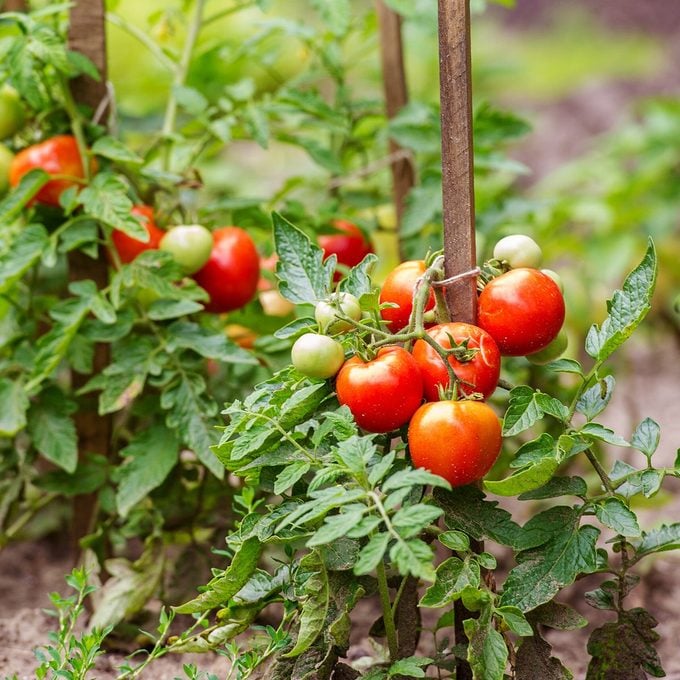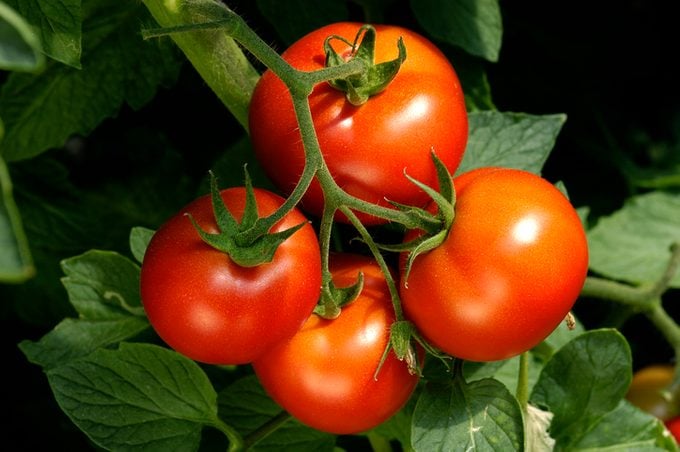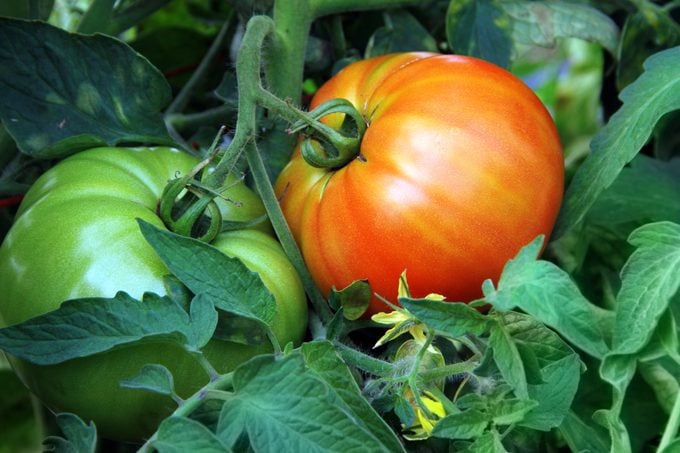14 Top Tomato Growing Tips for the Ultimate Crop
Updated: Feb. 27, 2024
Whether you're new to gardening or an old pro looking for secrets, learn to make the most of your veggie crop with these tomato growing tips.

In terms of popularity, it’s no contest: Tomatoes are the rock stars of veggies. More than 35 million gardeners plant tomatoes each year! Even if you’re new to gardening, it’s easy to make your backyard the neighborhood Tomatoville with our top tomato growing tips!
Start Tomatoes From Seeds
Buying and setting out transplants is the easiest tomato growing tip. But to explore the many distinctive varieties available, start seeds indoors. Six to eight weeks before the last frost, sow seeds in pots filled with seed-starting or potting mix. When the seedlings sprout two sets of leaves, transplant them into bigger containers.
Seek the Heat and Protect Tomatoes From Cold
Seedlings need lots of light and heat. Put them in a sunny window, or 4 to 6 inches under an artificial light, to encourage stout stems. To prepare for transplanting, set them outside for a few hours daily in early spring. When temperatures stay above 55, it’s time to plant.
Tuck tomatoes in at night with a cloche or other cover to protect them from frosty temps. Try a cold frame (for seedlings), tunnel row covers (once plants are in the ground), water barriers, or an old cloth or plastic tarp. If exposed to 32 degrees, these plants will likely die, so shelter is key!
Don’t make these mistakes with your tomato garden.
Plant Tomatoes in Full Sun
Set yourself up for success by making sure tomatoes are planted in a space that receives a lot of direct sunlight. “They can get by with six hours of sun but, ideally, eight hours or more is best,” says Diane Blazek, executive director of the National Garden Bureau and All-America Selections. “Less than eight hours of sunlight results in fewer and smaller fruits.” Warm weather is important, too.
Support Tomato Vines
To help keep your tomatoes clean and disease-free, provide plenty of support with stakes, trellises or cages. Vining (also known as “indeterminate”) tomatoes will grow until killed by frost. Keep them off the ground with at least a 5- to 8-foot-tall cage or a trellis. Bush varieties (known as “determinate” tomatoes) are especially good choices for containers or small spaces. Use small stakes or cages.
Should you grow heirloom or hybrid tomatoes?
Try the Trench Method
Dig a 4-inch hole that’s as long as the plant is high. Pluck lower leaves off the stem, then place the plant in the trench horizontally, filling the trench with soil but keeping the remaining leaves above ground. “Planting horizontally in a trench or simply planting deeper in the soil allows the stem to shoot out new roots, giving the plant a sturdier base,” Diane says.
This method is ideal for large indeterminate tomatoes that develop heavy vines and fruits. The tomato growing tip also promotes speedy, healthy growth, because the plant grows toward the sun and the developing roots are buried shallowly to stay warm. Just make sure to water deeply.
Check out the top 5 tips for growing tomatoes indoors.

Amend Your Soil
Tomatoes grow well in soils with a slightly acidic pH level of 5.8 to 7, but they adapt nicely to slightly alkaline soils, too. If your soil is sandy or claylike, work in 2 to 3 inches of compost. Have your soil tested and follow the recommendations for best results.
Water Tomatoes Often
The best tomato growing tip is consistent watering. This helps prevent leaf-end roll, blossom-end rot and “cat facing”—those misshapen cracks you sometimes see on the stem end of the fruit. Give tomatoes at least an inch of water a week. Water in the morning to help prevent disease and leaf burn. And don’t water the leaves. As long as the plant continues to fruit, water deeply and thoroughly during dry periods.
Mulch Tomatoes to Prevent Disease
Mulch keeps soil moist, protects low-growing tomatoes from resting on the ground and helps prevent potentially disease-spreading soil from splashing onto the foliage during a good rain. It also controls weeds and keeps the soil cool. Use organic mulches, such as fall leaves, straw or marsh hay, or herbicide-free grass clippings. As these materials break down, they enrich the soil and improve its structure.
Prune and Remove Suckers
If you train tomatoes on a single stake for support, keep removing the suckers, those little shoots that appear in the crotch between the stem and branches. Suckers turn into fruiting stems, which lead to an even larger plant that’s hard to contain to a single stake. Removing them will give you fewer but earlier fruits. If you use tomato cages or let plants sprawl on the ground, leave the suckers on for a more fruitful harvest. And always keep the leaves, which produce the nutrients that make tomatoes delicious.
Here’s how to prevent the tomato hornworm from damaging your tomato harvest.
Ripen Tomatoes on the Vine
Be patient and wait until tomatoes are fully ripened and at their deepest color before harvesting. (Once the fruit is removed, its sugar supply is cut off.) Gently twist the fruit so the stem separates easily from the vine.
Psst—we found fast-growing vegetables you can harvest quickly.

Remove Flowers in Fall
About a month before the first frost, pluck new flower clusters off tomato plants to direct energy into already-set fruits.
Pick Tomatoes Before Frost
Before the first frost pays your garden a visit, pluck any remaining green tomatoes and place them on a windowsill or counter. If the tomato is in a warm spot, the fruit will ripen faster; a cooler location will slow ripening. Although the flavor won’t match vine-ripened, it will stretch your harvest a little more.
Learn how to freeze fresh tomatoes, step by step.
Do Not Refrigerate Tomatoes
You can store ripe tomatoes at room temperature for a few days. But taste-lovers beware: If kept in temperatures below 55 degrees, tomatoes lose their flavor. You want to keep ripe tomatoes cozy instead of cool. Store on a kitchen counter for a better-tasting bite. “Never store tomatoes in the fridge!” Diane says. “Refrigeration changes the taste and texture of tomatoes. Keep them at room temperature and use them as soon as they ripen.”
Get more advice on how to store vegetables so they stay fresh longer.
Plant Plenty of Tomatoes
A standard tomato growing tip says you’ll need two tomato plants for every tomato eater in your household. But if you plan on canning, four per person is a better bet. In either case, there’s plenty of good taste in store!
Discover 6 genius ways to use up extra tomatoes.
About the Expert
Diane Blazek is the executive director of the National Garden Bureau and All-America Selections (AAS), a non-profit organization that conducts impartial trials of new annual ornamentals, perennials and vegetables. Blazek assumed her current role in 2009, educating and inspiring consumers about gardening.
Why Trust Us?
For nearly 30 years, Birds & Blooms, a Trusted Media Brand, has been inspiring readers to have a lifelong love of birding, gardening and nature. We are the #1 bird and garden magazine in North America and a trusted online resource for over 15 million outdoor enthusiasts annually. Our library of thousands of informative articles and how-tos has been written by trusted journalists and fact-checked by bird and garden experts for accuracy. In addition to our staff of experienced gardeners and bird-watchers, we hire individuals who have years of education and hands-on experience with birding, bird feeding, gardening, butterflies, bugs and more. Learn more about Birds & Blooms, our field editor program, and our submission guidelines.
